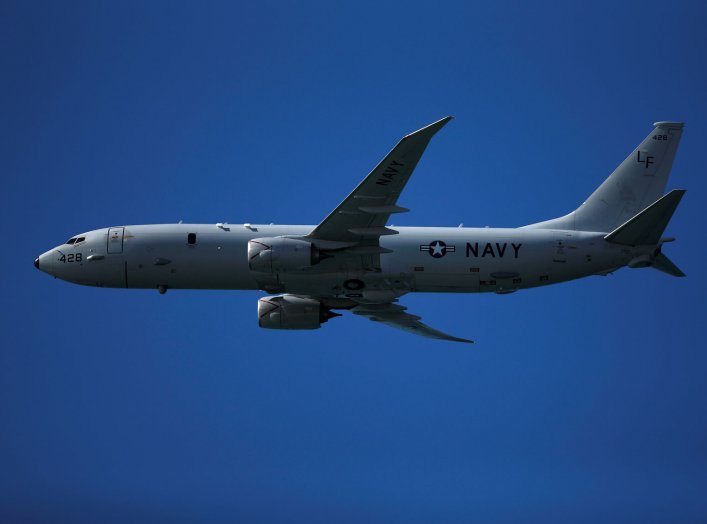
Rival U.S. and Chinese sub-hunting surveillance assets continue to track one another in the South China Sea as part of an ongoing competition to both gain intelligence about the other and, ideally, establish some kind of maritime superiority in the South China Sea in light of ongoing tensions.
The Chinese have been operating KJ-500 airborne early warning and control systems and KQ-200 Y8 sub-hunting aircraft in the South China Sea area, according to the Global Times.
Citing Taiwanese media reports pointing to satellite images, the Global Times quotes Chinese experts saying “China has the right to deploy defensive weapons there, according to the military threats China is facing.” While it notes that Chinese officials have not formally confirmed the missions, the report quotes Chinese leaders emphasizing the country’s right to defend its national security interests.
Satellite images of Chinese weapons and surveillance operations in the South China Sea are by no means unprecedented, as they have previously been identified on numerous occasions. At one point there were multiple reports of Chinese artillery, rockets and land war assets being placed in the South China Sea, as well as reported satellite images of fighters being placed in the island region. Years ago, U.S. Poseidon P-8 surveillance planes detected phony island-building, or “land reclamation” in the area, at times identifying overt Chinese efforts to build airplane landing strips on newly added territories.
Submarine operations would, of course, be of critical significance in any kind of South China Sea military engagement. The expansive shallow-water coastal areas surrounding islands in the South China Sea naturally make it more difficult for deep draft surface ships to operate in the area, perhaps apart from shallow-draft Navy Littoral Combat Ships. Submarines, therefore, can more closely approach, surveil and attack coastal regions, bringing a decided tactical advantage. Surveillance planes could also help find undersea and surface drones likely to be deployed in the region for intelligence, surveillance, and reconnaissance (ISR) missions or attack.
Given all this, as part of a commensurate counter-effort, the United States has been continuing Chinese sub-hunting patrols with its Poseidon P-8 surveillance plane in the South China Sea area. It takes little imagination to envision ways its advanced sensors, sonobuoys and weapons could function as part of a containment strategy against Chinese expansion—and even operate as a deterrent against China’s growing fleet of nuclear-armed ballistic missile submarines (SSBN).
The extent of the Y-8s anti-submarine technology may remain somewhat of a mystery, as it may or may not effectively rival the new, upgraded U.S. P-8 Poseidon. Alongside ISR-enabled SSN attack submarines, the Poseidon seems well-positioned to help perform the U.S. SSBN sub-hunting mission for a number of reasons. Not only is the P-8’s 564 mph speed considerably faster than the P-3 Orion it is replacing, but its six additional fuel tanks enable it to search wide swaths of ocean and spend more dwell-time patrolling high-threat areas. Navy developers explain the Poseidon can operate on ten-hour missions at ranges out to twelve hundred nautical miles. More dwell-time capacity, fortified by high-speeds, seems to position the Poseidon well for covering wide areas in search of “hidden” Chinese SSBNs.
The P-8A, a militarized variant of Boeing’s 737-800, includes torpedo and Harpoon weapons stations, 129 sonobuoys and an in-flight refueling station, providing longer ranges, sub-hunting depth penetration and various attack options. Given that a P-8 can conduct sonobuoy sub-hunting missions from higher altitudes than surface ships, helicopters or other lower-flying aircraft, it can operate with decreased risk from enemy surface fire and swarming small boat attacks. Unlike many drones and other ISR assets, a Poseidon can not only find and track enemy submarines but attack and destroy them as well.
Alongside its AN/APY-10 surveillance radar and MX-series electro-optical/infrared cameras optimized to scan the ocean surface, the Poseidon’s air-parachuted sonobuoys can find submarines at various depths beneath the surface. The surveillance aircraft can operate as a “node” within a broader sub-hunting network consisting of surface ships, unmanned surface vessels, aerial drone-mounted maritime sensors and submarines. As part of its contribution to interconnected sub-hunting missions, the Poseidon can draw upon an Active Electronically Scanned Array, Synthetic Aperture Radar and Ground Moving Target Indicator.
By lowering hydrophones and a magnetic compass to a predetermined depth, connected by cable to a floating surface radio transmitter, Poseidon sonobuoys can convert acoustic energy from the water into a radio signal sent to aircraft computer processors, according to a June 2018 issue of “Physics World.”
Also, Poseidon-dispatched sonobuoys can contribute to the often discussed “US Navy Fish Hook Undersea Defense Line,” a seamless network of hydrophones, sensors and strategically positioned assets stretching from coastal areas off of Northern China down near the Philippines all the way to Indonesia, according to an essay from the Carnegie Endowment for International Peace, called “China’s Nuclear Ballistic Missile Submarines and Strategic Stability.”


No comments:
Post a Comment